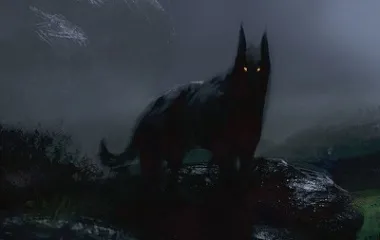Black. To many, it’s a color associated with death, evil, and bad luck, but to some, it’s associated with protection and power. Pagans, witches, and spiritualists, both ancient and modern, see it as a strong color with the ability to guard and protect what they hold dear while also representing mourning and death. It’s a double-edged sword that seems to have no in-between… except when it finally begins to take shape. Enter church grims and the stories they carry.
A guardian spirit of English and Scandinavian folklore, church grims (known in some cases as black dogs or demon dogs) are typically large black dogs placed in charge of protecting a specific church and often the bodies buried there. Additionally, they have been known to frequent crossroads, castles, old fortresses, and more. Black Shuck, Moddey Doo, and numerous other legends are all examples of such creatures, though their behaviors and their hauntings vary in detail and meaning. Like many spirits, their morals and intentions are not always exact.
The most famous of the pack is arguably Black Shuck. Also called Old Shuck, Old Shock, or simply Shuck, this massive black dog was known for wandering the coastline and countryside of East Anglia. In some cases, the locals take him very seriously, and he’s been part of the culture there for generations. Some legends say that he is an omen of death, that seeing him means your death will come within the year. Some posit that his howl is so horrible that it will literally kill you to hear. The rare few, however, paint him as a benevolent figure. Shuck has been said to behave as a companionable guard dog for those who need it, though whether that’s him or another folkloric canine cannot be confirmed. Anyone to draw his ire should be shaking in their boots, as his size is cited as ranging anywhere from the size of a calf to that of a horse… and a creature with such an ambiguous and potentially malevolent nature is not one that anyone in their right mind wants to go up against.
Not all church grims and black dogs are violent, however. Though less known than Shuck, the Gurt Dog of Somerset is said to be a benevolent entity. Mothers would trust it to watch over their children as they played unsupervised in the hills, and it was known to guide lone travelers as they came through the area. Whether murderous or not, all legends speak of church grims as dedicated protectors of their assigned territory. In fact, despite black dogs being called hellhounds and devil dogs by many legends, those that operate as church grims are actually known for chasing off vandals, thieves, witches, warlocks, and even the Devil himself.
The Moddey Doo (more accurately known as the Mauthe Doog) is one such keeper of order. A massive black spaniel with shaggy, curly fur haunting Peel Castle may sound like nothing more than fiction, but perhaps there’s some truth to the story. George Waldron, when writing History and Description of the Isle of Man, described the legend as follows:
"They say, that an apparition called, in their language, the Mauthe Doog, in the shape of a large black spaniel with curled shaggy hair, was used to haunt Peel Castle; and has been frequently seen in every room, but particularly in the guard-chamber, where, as soon as candles were lighted, it came and lay down before the fire in presence of all the soldiers, who at length, by being so much accustomed to the sight of it, lost great part of the terror they were seized with at its first appearance."
Additionally, Waldron also described an incident in which a drunken castle guard made the choice to break the routine and tried to lock up the castle all on his own. Snatching up the keys, he headed down the eerie passage Moddey Doo was said to haunt when it wasn’t his turn. Noises sounded from within the darkness, and seconds later, he returned to the guardroom pale as a ghost. Too frightened to share what he had seen, he died within three days. That was the last time anyone saw the dog, and the passage was sealed up shortly after. The story has some variations, some saying that it was a soldier who made the mistake, some saying that Moddey Doo is just as malevolent as its many cousins, but the beats are all the same. It seems that should the black hound be real, it had strong opinions on what was done with the castle it haunted.
Whether you feel that the church grim and black dog are awful monsters out to get you or simply very diligent canines with a job to do is up to you, but Folklore Corner hopes you learned something new and allowed these legends to enrapture you either way. The next time you pass a graveyard or walk into a church, perhaps you’ll think about what might be keeping the sanctity there, and should you ever travel to England or Sweden and Denmark, maybe you’ll keep your eyes peeled for mysterious canine shapes on the horizon. Whatever your opinion and wherever your journeys take you, remember to take care and stay safe out there.
Sources:
header image from https://i0.wp.com/sandyriverreview.com/wp-content/uploads/2019/02/Black-Dog-Ghost-380x240.jpg?fit=380%2C240&ssl=1
https://en.wikipedia.org/wiki/Black_Shuck
https://mythus.fandom.com/wiki/Black_Shuck
https://en.wikipedia.org/wiki/Black_dog(folklore)_
https://en.wikipedia.org/wiki/Church_grim
https://en.wikipedia.org/wiki/Moddey_Dhoo
https://www.transceltic.com/manx/manx-castle-haunted-phantom-hound-moddey-dhoo

 Opinion: The Bitter History of BetterHelp
Opinion: The Bitter History of BetterHelp